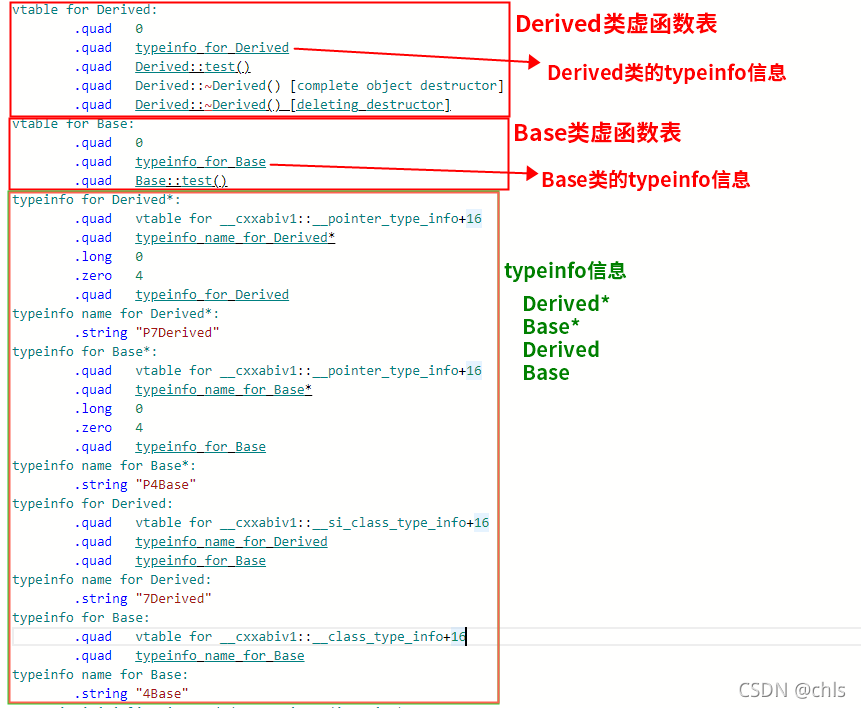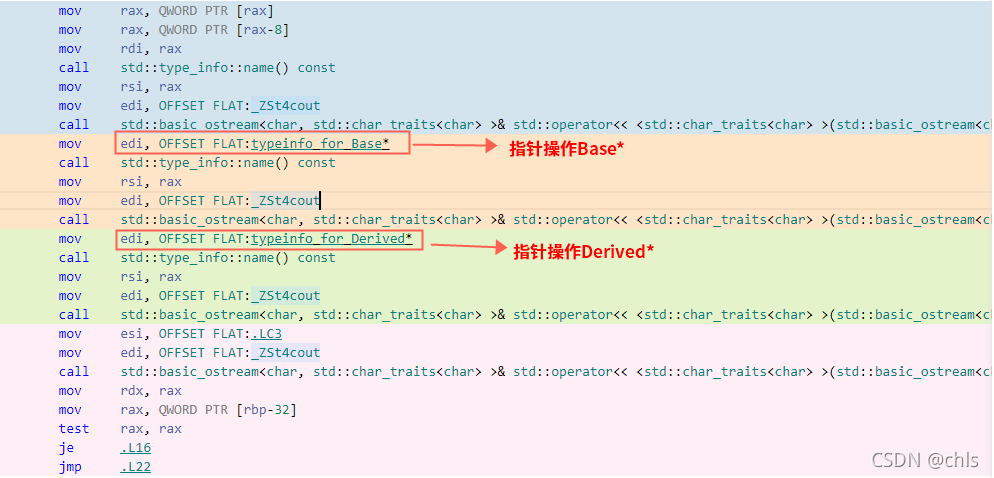typeid 和虚函数
前面咱们讲到 typeid 的操作返回值是 type_info 对象的引用,然后输出返回值的地址是相同的,测试代码如下:
#include <iostream>
#include <functional>
using namespace std;
class Base{
public:
virtual
void test(){
cout << "Base::test" << endl;
}
};
class Derived : public Base{
public:
void test(){
cout << "Derived::test" << endl;
}
virtual
~Derived(){
cout << "Derived::~Derived" << endl;
}
};
int main()
{
Base* pBase = new Base();
Base* pBase2 = new Derived();
Derived* pDerive = new Derived();
//typeid(pBase2) 和 typeid(pDerive) 返回地址相同
cout << "typeid(pBase2) = " << &typeid(*pBase2) << " typeid(pDerive) = "<< &typeid(*pDerive) << endl;
return 0;
}
output信息:
typeid(pBase2) = 0x55dd724c6d48 typeid(pDerive) = 0x55dd724c6d48
也就是说,0x55dd724c6d48 就是 Derived 类编译之后的类标识(type_info)数据信息!是否真的如此,咱们可以添加一下代码测试:
int main()
{
Base* pBase = new Base();
Base* pBase2 = new Derived();
Derived* pDerive = new Derived();
//typeid(pBase2) 和 typeid(pDerive) 返回地址相同
cout << "typeid(pBase2) = " << &typeid(*pBase2) << " typeid(pDerive) = "<< &typeid(*pDerive) << endl;
//class Base type_info 地址
cout << "typeid(Base) = " << &typeid(Base) << endl;
//class Derive type_info 地址
cout << "typeid(Derived) = " << &typeid(Derived) << endl;
//指针类型推导
cout << "point ---- typeid(pBase2) = " << &typeid(pBase2) << " typeid(pDerive) = "<< &typeid(pDerive) << endl;
return 0;
}
ouput信息:
typeid(pBase2) = 0x562309345d48 typeid(pDerive) = 0x562309345d48
typeid(Base) = 0x562309345d60
typeid(Derived) = 0x562309345d48
point ---- typeid(pBase2) = 0x562309345d28 typeid(pDerive) = 0x562309345d08
可以看到,Derived 类的 type_info 信息的地址就是 0x558a4dec7d48 !要注意的一点:直接对指针类型进行操作,并不能返回正确的原始类型。
好了嘛,那 typeid 到底是咋从虚函数表找到这个地址的呢?如果大家看过我之前的 深入理解new[]和delete[]_master-计算机科学专栏-CSDN博客 一文,应该就能够想到是不是C++编译器对虚函数表进行构造的过程中是不是也一样,做了地址偏移呢?
咱们看看上面代码的汇编信息:

通过查看汇编信息,我们得到以下结论:
虚函数表中确实存有typeinfo信息(第一个虚函数的地址偏移 -1 即是)typeinfo信息是区分指针类型是的(指针类型有前缀P,例如 P4Base、P7Derived)
然后,我们仔细观察四个 typeinfo 类(Derived*、 Base*、Derived、Base),每个typeinfo 类都有一个虚函数表,继承自 vtable for __cxxabiv1::******* ,后面的信息会不一样。这里对该信息做一下简单说明:
对于启用了 RTTI 的类来说会继承 __cxxabiv1 里的某个类所有的基础类(没有父类的类)都继承于_class_type_info所有的基础类指针都继承自 __pointer_type_info所有的单一继承类都继承自 __si_class_type_info所有的多继承类都继承自 __vmi_class_type_info以typeinfo for Derived为例:
然后是指向存储类型名字的指针,
如果有继承关系,则最后是指向父类的 typeinfo 的记录。
所以,如果是正常调 typeinfo 基类(_class_type_info、__pointer_type_info、__si_class_type_info、__vmi_class_type_info)的方法,应该会动态调到 type_info 的继承类 (typeinfo for Derived*、typeinfo for Base*、typeinfo for Derived、typeinfo for Base)的方法。
但是,typeid 操作指针类型时并不是这样,说明C++编译器底层有特殊处理!
调试以下代码:
cout << typeid(*pBase2).name(); cout << typeid(*pDerive).name(); cout << typeid(pBase2).name(); cout << typeid(pDerive).name();
通过汇编信息,可以看到这里并没有做任何动态调用的逻辑,而是直接返回该指针类型的typeinfo信息,这也就解释了为什么 typeid 操作指针和操作对象的结果不一样!

那么我们在使用typeid时,如果要获取到真实对象类型,应该要将指针去掉!
为了验证我们前面的结论: 虚函数表中确实存有typeinfo信息(第一个虚函数的地址偏移 -1 即是),咱们可以直接通过指针的方式操作虚函数表!
测试代码如下:
#include <iostream>
#include <functional>
using namespace std;
class Base{
public:
virtual
void test(){
cout << "Base::test" << endl;
}
};
class Derived : public Base{
public:
void test(){
cout << "Derived::test" << endl;
}
virtual
~Derived(){
cout << "Derived::~Derived" << endl;
}
};
typedef void (*FUNPTR)();
type_info* getTypeInfo(unsigned long ** vtbl){
type_info* typeinfo = (type_info*)((unsigned long)vtbl[-1]);
return typeinfo;
}
void visitVtbl(unsigned long ** vtbl, int count)
{
cout << vtbl << endl;
cout << "\t[-1]: " << (unsigned long)vtbl[-1] << endl;
typedef void (*FUNPTR)();
for (int i = 0; vtbl[i] && i < count; ++i)
{
cout << "\t[" << i << "]: " << vtbl[i] << " -> ";
FUNPTR func = (FUNPTR)vtbl[i];
func();
}
}
int main()
{
Base* pBase = new Base();
Base* pBase2 = new Derived();
Derived* pDerive = new Derived();
//这里去遍历虚函数表
visitVtbl((unsigned long **)*(unsigned long **)pBase2, 2);
//获取虚函数表-1位置的typeinfo地址
cout << "pDerive = " << getTypeInfo((unsigned long **)*(unsigned long **)pDerive) << " "
<< getTypeInfo((unsigned long **)*(unsigned long **)pDerive)->name() << endl;
//获取虚函数表-1位置的typeinfo地址
cout << "pBase2 = " << getTypeInfo((unsigned long **)*(unsigned long **)pBase2) << " "
<< getTypeInfo((unsigned long **)*(unsigned long **)pBase2)->name() << endl;
return 0;
}
这里要注意的一点是,遍历虚函数表 visitVtbl 方法的第2个参数,自己控制不要越界,此外,还要注意调用的顺序,如果先调用了虚析构函数,会导致内存错误!
output信息:
0x5620022edd10
[-1]: 94695475567936
[0]: 0x5620022eb5fa -> Derived::test
[1]: 0x5620022eb636 -> Derived::~Derived
pDerive = 0x5620022edd40 7Derived
pBase2 = 0x5620022edd40 7Derived
通过直接访问虚函数表-1位置,我们可以看到输出的日志信息与我们前面的结论是一致的!也即是C++编译器给我们做了偏移操作(在-1的位置存储了type_info信息,实例化对象中的虚函数表地址是偏移之后的地址)。
总结
本篇文章就到这里了,希望能够给你带来帮助,也希望您能够多多关注服务器之家的更多内容!
原文链接:https://blog.csdn.net/zhaxun/article/details/120166140















